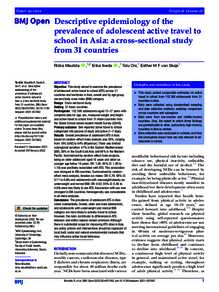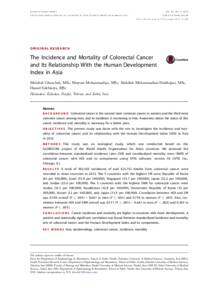Document
Descriptive epidemiology of the prevalence of adolescent active travel to school in Asia : a cross-sectional study from 31 countries.
Identifier
DOI: 10.1136/bmjopen-2021-057082
Source
BMJ Open. v. 12, 4, e057082
Contributors
Country
United Kingdom.
City
London
Publisher
BMJ Publishing Group.
Gregorian
2022-04-07
Language
English
English abstract
Objective This study aimed to examine the prevalence of adolescent active travel to school (ATS) across 31 countries and territories in Asia, overall and by age group, sex and body mass index (BMI) category. Design Cross-sectional study. Setting 31 Asian countries. Participants 152 368 adolescents aged 13-17 years with complete data for age, sex, measured weight and height and active travel to school from 31 Asian countries from the Global School-based student Health Survey (GSHS). Primary outcome Self-reported active travel to school categorised into passive (0 days) and active (1-7 days). Results Overall prevalence of adolescent ATS in Asia based on random-effect meta-analysis was 55%, ranging from 18% (UAE) to 84% (Myanmar). There was limited subregional variation: 47% in the Eastern Mediterranean (EM), 56% in the South East Asia and 64% in the Western Pacific. Summarised by random-effect meta-analysis, being an older adolescent aged 16 years and older (vs younger age below 16 years: OR: 1.08; 95% CI: 1.00 to 1.16) was positively associated with ATS. This association was strongest in EM countries. Summarised by random-effect meta-analysis, females (vs males: OR: 0.79; 95% CI: 0.71 to 0.89) and adolescents with overweight/obesity (vs underweight and normal BMI: OR: 0.92; 95% CI: 0.86 to 0.99) were less likely to use ATS. Association with sex was strongest in EM countries. Heterogeneity was considerable in all meta-analyses. Conclusion The prevalence of adolescent ATS in Asia varies substantially. Overall, older and male adolescents, and adolescents with underweight and normal BMI category are more likely to actively travel to school. However, the main contributor to differences in ATS between and within regions remain unknown. Although there is substantial scope for improving ATS rates in Asia, any policy actions and interventions should be cognisant of local built, social and natural environmental contexts that may influence active travel behaviour.
ISSN
2044-6055
Resource URL
Category
Journal articles


